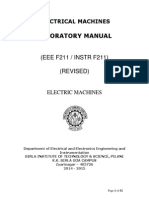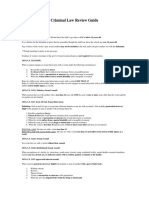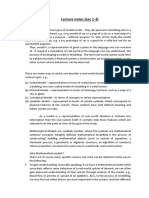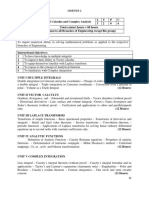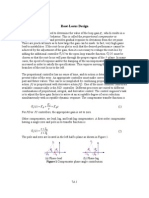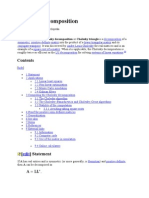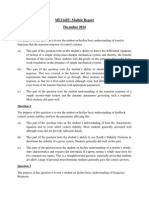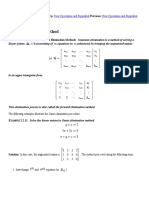Modeling and Simulation of Dynamic Systems: Lecture Notes of ME 862
Uploaded by
RajrdbModeling and Simulation of Dynamic Systems: Lecture Notes of ME 862
Uploaded by
RajrdbLecture Notes of ME 862
Modeling and Simulation of Dynamic Systems
Department of Mechanical Engineering, University Of Saskatchewan, 57 Campus Drive, Saskatoon, SK S7N 5A9, Canada
Lecture Notes of ME 862
1. Modeling of Dynamic System
A model of a system can be physical or mathematical. The model accuracy needed (closeness to the actual system) depends on the purpose. Generally, a simplified model is needed to study the main characteristics of the system. A detailed model is needed for accurate simulation and prediction studies. In this class, modeling refers to the mathematical model of a system. The mathematical model of a dynamic system is generally in the form of differential equations. Therefore, modeling of dynamic system refers to the use of the physical laws to set up differential equations for a given dynamic system. Once we have the model of the system, we are interested in studying its behavior. The behavior of a dynamic system in time is described by the solution of its differential equations. There two different purposes for modeling of a physical system. Develop a mathematical model in order to predict the dynamic behavior of the system as accurately as possible, using numerical methods. Such a model serves as a tool for extensive evaluation of system behavior without actually using or building the actual system. Develop model to gain insight into the dynamic behavior qualitatively instead of exact response prediction, i.e., knowledge of stability margin, controllability and observability of states, and sensitivity of response to parameter changes. Such models do not contain all the detail of an actual system, but only the most essential features so as to provide good insight from an engineering standpoint. Therefore, we may develop simplified linear models for controller design and analysis purposes, and use more detailed, possibly nonlinear, models in testing and predicting the dynamic system response as accurately as possible. For instance, consider the robotic manipulator schematically shown in Figure 1. The dynamic model is a set of differential equations which describe the relationship between the applied torques at the joints and motion of the joint angles in time. The set of nonlinear differential equations can be used to predict the behavior of the robotic manipulator under various initial conditions and joint torque inputs. Quite often, the dynamics models of physical systems are nonlinear. Most control system design methods and analytical methods are applicable only to linear systems. Therefore, for the sake of being able to analyze various controller alternatives, we need to obtain approximate linearized modes from the nonlinear models. Figure 1: Robotic manipulator model
Department of Mechanical Engineering, University Of Saskatchewan, 57 Campus Drive, Saskatoon, SK S7N 5A9, Canada
Lecture Notes of ME 862
2. Differential Equations
2.1 Basics of Differential Equations Continuous time dynamic systems are described by differential equations. A differential equation is an equation involving derivatives of dependent variables with respect to independent variables, for example,
dy (t ) + ay (t ) = u(t ) dt where t is an independent variable, y is a dependent variable (e.g. the system output), and u is another dependent variable (e.g., the system input). If there is only one independent variable, then the differential equation is called an ordinary differential equation (ODE). If there are two or more independent variables, then it is called a partial differential equation (PDE). The highest derivative in the equation is the order of the equation. Solution of an nthorder differential equation contains n-arbitrary constants. These constants are determined by n-conditions on dependent variable (i.e., the initial conditions)
2.2 Nonlinearities and Linearization
If the dependent variables or their derivatives appear in nonlinear functions in the equations, then the differential equation is nonlinear; otherwise it is linear. For example, the following equation is nonlinear
dy 2 (t ) dy (t ) + + ay (t ) = u(t ) dt 2 dt A system is called a linear dynamic system if its dynamics is described by linear differential equation(s). A linear system possesses two properties: superposition and Homogeneity. The property of superposition means the output response of a system to the sum of inputs is the sum of the responses to the individual inputs. Thus, if an input of r1(t) yields an output of c1(t) and an input of r2(t) yields an output of c2(t), then an input of r1(t)+r2(t) will yield an output of c1(t)+c2(t). The property of homogeneity describes the response of the system to a multiplication of the input by a scalar. Specifically, in a linear system, the property of homogeneity is demonstrated if for an input of r(t) that yields an output of c(t), an input of Kr(t) will yield an output of Kc(t). In other words, the multiplication of an input by a scalar (i.e., K) yields a response that is multiplied by the same scalar. Quite Often, a designer needs to make a linear approximation to a nonlinear system. Linear approximations simplify the analysis and design of a system and are used as long
3
2
Department of Mechanical Engineering, University Of Saskatchewan, 57 Campus Drive, Saskatoon, SK S7N 5A9, Canada
Lecture Notes of ME 862
as the results yield a good approximation to reality. For example, if a system consists of nonlinear components, we must linearize the system before we can find its transfer function. Now, lets see how to linearize a nonlinear system in order to obtain its transfer function. The first step is to write the nonlinear differential equation and linearize it. When we linearize a nonlinear differential equation, we linearize it for small changes in the input about the operating point A, as shown in Figure 2, where the system input and the output are x0 and f(x0), respectively. Small changes in the input can be related to changes in the output about the point by way of the slope of the curve at the point A. Thus, if the slope of the curve at pint A is ma, then small excursions of the input about pint A, x, yield small changes in the output, f(x), related the slope at point A. Thus,
f ( x ) = f ( x ) f ( x0 ) = ma ( x x0 )
where ma = Figure 2: Linearization about the operating point A. Once we have the linearized differential equation, next we take the Laplace transform of the equation(s), assuming zero initial conditions. Finally, we separate input and output variables and form the transfer function.
Example 1
df ( x ) dx
x = x0
(a) Write the differential equation for the simple pendulum shown in the following figure, where all the mass is concentrated at the endpoint. (b) Linearize the system about the operating point of =0 and then find its transfer function. (c) Use SIMULINK to determine the time response of to a step input Tc of 1 Nm. Assume l =1 m, m = 0.5 kg, and g = 9.81 m/s2.
Department of Mechanical Engineering, University Of Saskatchewan, 57 Campus Drive, Saskatoon, SK S7N 5A9, Canada
Lecture Notes of ME 862
Example 2
Find the transfer function, VL(s)/ V(s), for the electrical network shown in the following figure, which contains a nonlinear resistor whose voltage-current relationship is defined by i r = 2e 0.1v r , where ir and vr are the resistor current and voltage, respectively. Also, it is know that v(t) is a small-signal source. Use SIMULINK to determine the time response of vL(t) to a step input v(t) of 0.1 V.
Department of Mechanical Engineering, University Of Saskatchewan, 57 Campus Drive, Saskatoon, SK S7N 5A9, Canada
Lecture Notes of ME 862
3. Numerical Systems
Simulation
of
Nonlinear
Dynamic
The behavior of a dynamic system in the time domain can be predicted by the solution of its mathematical model, which typically is a set of ordinary differential equations (ODEs). Analytical solution of ODEs is available for only linear ODEs and very simple nonlinear ODEs. Therefore, time domain response of any dynamic system model with reasonable complexity must be solved using numerical methods. The primary tool is the numerical integration of ODEs in the time domain. Numerical integration is performed by discretizing ODEs using various approximations to differentiation.
3.1 Basics for Solving a First-Order ODE
Given that a dynamic system is describe by the following first-order ODE
& = f ( y, u ) y
The task at hand is to solve for y(t) given the initial condition y (t0 ) = y0 and the input u(t). The fundamental idea behind numerical integration is illustrated in Figure 3, in which
y (t i +1 ) = y (t i ) + where
t i +1
ti
& dt y
t i +1
ti
& dt can be obtained by using various approximations, such as the Eulers and y
Runge-Kutta methods introduced in the following.
& y
& y
& d y
0 t
& y
Figure 3: Graphical interpretation of numerical integration for solving a first-order ODE.
Department of Mechanical Engineering, University Of Saskatchewan, 57 Campus Drive, Saskatoon, SK S7N 5A9, Canada
Lecture Notes of ME 862
3.2 Eulers Method and Runge-Kutta Methods Eulers method is based on the definition of a derivative, i.e.,
dy y = lim dt t 0 t
Let us examine the differential equation for two values of time, ti and ti+1, where t is sufficiently close to zero that the above equation is approximated by
y i +1 y i = f ( y i , ui ) t which can be rewritten as y i +1 = y i + tf ( y i , ui ) Repeated evaluation of the above equation leads to the numerical solution. As the initial point, y i = y 0 and, for subsequent values of the index i+1, yi+1 takes on the value from the previous calculation of yi. Any arbitrary time history of the input ui can be used: steps, ramps, sinusoids, random sequences, or stock market indices. As the step size t decreases, the accuracy of the method improves and the required computation time increases. Figure 3 suggests that a more accurate formula is to use the average of the values of the & derivative at ti and ti+1. Because this is essentially a straight line approximation to the y curve between ti and ti+1, it is called the trapezoidal rule. Unfortunately, it is impossible to implement for numerical integration of nonlinear system because the derivative at ti+1 depends on y(ti+1), which is not known yet. Many different numerical integration schemes have been developed to approximate the area under the curve; and they are all iterative because the derivative at the endpoint is not initially known.
Runge-Kutta methods comprise one popular set of integration schemes. The secondorder Runge-Kutta method obtains an approximate value of the endpoint using the Euler method, estimates the derivative at the endpoint using the approximate yi+1, and then arrives at the final value for yi+1 using an average of the two derivatives:
k1 = f ( y i , u i ) k 2 = f ( y i + k1t, ui +1 ) y i +1 = y i + t ( k1 + k 2 ) 2
Department of Mechanical Engineering, University Of Saskatchewan, 57 Campus Drive, Saskatoon, SK S7N 5A9, Canada
Lecture Notes of ME 862
Third- and higher-order Runge-Kutta methods use this same basic idea; they differ from the second-order formula by using estimates of derivatives at mid-points as well as endpoints and including them in a weighted average to arrive at the final estimate of yi+1. Most computer-aided control system design software includes some form of numerical integration capability such as Runge-Kutta method and most will include some sort of automatic step size determination. Any method will be become more accurate as the step size decrease: however, initially, neither the computer algorithms nor the user knows what step size is the best compromise between accuracy and speed. A commonly used scheme is to integrate using two different methods (perhaps a second- and third-order Rung-Kutta formula), compare the difference, and then cut the step size in half if the error exceeds a certain tolerance. The step size will continue to be cut in half until the error tolerance is met.
3.3 Simulation of Nonlinear Dynamic Systems Using SIMULINK
In SIMULINK, we use a block, called Integrator, for continuous-time integration of its input signal, i.e., S out = S in dt , where t is the step size (specified in the Solver options
0 t
in SIMULINK). The initial condition of integration can be specified via the Function Block Parameters window of the block.
Sin
1 s
Sout
Figure 4: Integrator in SIMULINK.
Suppose a dynamic system is describe by the following n-order ODE y ( n ) = f ( y ( n 1) , y ( n 2 ) ,L, y , u ) with initial conditions:
( n 1) y ( n1) (t 0 ) = y0 , ( n 2 ) y ( n2 ) (t 0 ) = y0 ,
y ( t 0 ) = y0 .
The general process to solve the above ODE by means of SIMULINK is discussed in class.
Department of Mechanical Engineering, University Of Saskatchewan, 57 Campus Drive, Saskatoon, SK S7N 5A9, Canada
Lecture Notes of ME 862
Example 3
Use SIMULINK to determine the time response of to a step input of 1 Nm of the pendulum in Example 1 based on the nonlinear differential equation obtained; and then compare it to the result from the transfer function after linearization.
Example 4
Consider the liquid level in a tank and its control system shown in the following figure. The purpose of control is to maintain the liquid height in the tank at a constant level. Let us consider a computer-controlled version of the system: the mechanism for manipulating the inflow rate to the tank is controlled by a level sensor, a digital controller, and a valve. The digital controller is an ON/OFF type one with hysteresis: the controller either fully turns ON or OFF the value, depending the error signal to the controller; and the hysteresis is added to the controller in order to make sure the controller does not switch the valve ON/OFF at high frequency due to small change in the liquid level. This type of controller is called relay with hysteresis. The inflow rate is proportional to the valve opening. Manipulated by the aforementioned ON/OFF controller, the flow rate has the value of either zero or maximum. The outflow rate is proportional to the liquid level in the tank by multiplying a constant of 1/R. Simulate the system for the following conditions: (1) the hysteresis band of the controller is [-0.05, 0.05], (2) the maximum inflow rate is 0.02 m3/s, (3) R has a value of 500 m/( m3/s), and (4) the cross-section area of the tank is 0.01 m2.
Department of Mechanical Engineering, University Of Saskatchewan, 57 Campus Drive, Saskatoon, SK S7N 5A9, Canada
You might also like
- Electrical Machines Lab Manual - 2014-15 - Cycle I-11!08!2014No ratings yetElectrical Machines Lab Manual - 2014-15 - Cycle I-11!08!201452 pages
- Pa State Police Study Guide Criminal Law Review GuideNo ratings yetPa State Police Study Guide Criminal Law Review Guide4 pages
- Topic 10 Nonlinear Systems and Their LinearizationsNo ratings yetTopic 10 Nonlinear Systems and Their Linearizations20 pages
- Mathematical Modelling in Control SystemNo ratings yetMathematical Modelling in Control System2 pages
- State Errors - Steady: Eman Ahmad KhalafNo ratings yetState Errors - Steady: Eman Ahmad Khalaf28 pages
- EACT633 - Optimal Control and It's Applications Worksheet For Chapter 4, 5 & 6No ratings yetEACT633 - Optimal Control and It's Applications Worksheet For Chapter 4, 5 & 63 pages
- Applications of Laplace Transform Unit Step Functions and Dirac Delta FunctionsNo ratings yetApplications of Laplace Transform Unit Step Functions and Dirac Delta Functions8 pages
- Introduction To Discrete Control SystemNo ratings yetIntroduction To Discrete Control System34 pages
- 15MA102 Advanced Calculus and Complex Analysis PDFNo ratings yet15MA102 Advanced Calculus and Complex Analysis PDF2 pages
- Stability and Steady-State Response Analyzes: Lectures 21-24No ratings yetStability and Steady-State Response Analyzes: Lectures 21-2451 pages
- 2.1 Mathematical Models in Industrial Context PDFNo ratings yet2.1 Mathematical Models in Industrial Context PDF16 pages
- 10.3 - Eigenvalues and Eigenvectors - Engineering LibreTexts Bien Explicado Matrix CalNo ratings yet10.3 - Eigenvalues and Eigenvectors - Engineering LibreTexts Bien Explicado Matrix Cal15 pages
- Linear Control System Lab: Familiarization With Transfer Function and Time ResponseNo ratings yetLinear Control System Lab: Familiarization With Transfer Function and Time Response14 pages
- Theory:: Experiment No: - 12 TITLE: Design Controller Using Pole Placement MethodNo ratings yetTheory:: Experiment No: - 12 TITLE: Design Controller Using Pole Placement Method4 pages
- KANNUR UNIVERSITY BTech.S7 EE SyllabusNo ratings yetKANNUR UNIVERSITY BTech.S7 EE Syllabus16 pages
- Regular Falsi Method: B.S. (SE) Semester Project ReportNo ratings yetRegular Falsi Method: B.S. (SE) Semester Project Report12 pages
- Feedback Control Systems (FCS) : Lecture-18 Steady State ErrorNo ratings yetFeedback Control Systems (FCS) : Lecture-18 Steady State Error23 pages
- Tutorial I Basics of State Variable ModelingNo ratings yetTutorial I Basics of State Variable Modeling11 pages
- Matlab Program Using Polynomial RegressionNo ratings yetMatlab Program Using Polynomial Regression4 pages
- Lecture 8 Routh Herwitz Stability CriterionNo ratings yetLecture 8 Routh Herwitz Stability Criterion25 pages
- Presentation 1 Introduction To Mechatronics (3) - 1No ratings yetPresentation 1 Introduction To Mechatronics (3) - 178 pages
- Apica Hybrid Application Performance Testing New 2018No ratings yetApica Hybrid Application Performance Testing New 201810 pages
- Paper-5 Analysis of Integrating External Trustworthiness Software & Study On Information Retrieval SystemsNo ratings yetPaper-5 Analysis of Integrating External Trustworthiness Software & Study On Information Retrieval Systems8 pages
- Compare and Contrast Essay Thesis Statements100% (3)Compare and Contrast Essay Thesis Statements6 pages
- B. Warmer Exercise 1: Write Verb 2 (Past Participle) of The Following VerbsNo ratings yetB. Warmer Exercise 1: Write Verb 2 (Past Participle) of The Following Verbs3 pages
- Pec 2 Declaration of Sentiments Seneca Falls 1848 Maximum Grade 22No ratings yetPec 2 Declaration of Sentiments Seneca Falls 1848 Maximum Grade 226 pages
- Places of the Soul Architecture and Environmental Design as a Healing Art 2nd Edition Christopher Day - Download the full ebook now for a seamless reading experience100% (1)Places of the Soul Architecture and Environmental Design as a Healing Art 2nd Edition Christopher Day - Download the full ebook now for a seamless reading experience71 pages
- Findings: Planning, Risk Coverage and SecuritiesNo ratings yetFindings: Planning, Risk Coverage and Securities3 pages
- 7.1 Coyne2019 - Ludwig Von Mises On War and The EconomyNo ratings yet7.1 Coyne2019 - Ludwig Von Mises On War and The Economy14 pages
- Fall Semester 2020-21 AI With Python ECE-4031No ratings yetFall Semester 2020-21 AI With Python ECE-40315 pages
- Powerful Hero Dpa Rtsal Protective DeityNo ratings yetPowerful Hero Dpa Rtsal Protective Deity50 pages
- Introduction and Background of Joseph AndrewsNo ratings yetIntroduction and Background of Joseph Andrews2 pages
- PDF Download For JEE Advanced Previous Year Questions With Solutions On GravitationNo ratings yetPDF Download For JEE Advanced Previous Year Questions With Solutions On Gravitation7 pages
- Electrical Machines Lab Manual - 2014-15 - Cycle I-11!08!2014Electrical Machines Lab Manual - 2014-15 - Cycle I-11!08!2014
- Pa State Police Study Guide Criminal Law Review GuidePa State Police Study Guide Criminal Law Review Guide
- Topic 10 Nonlinear Systems and Their LinearizationsTopic 10 Nonlinear Systems and Their Linearizations
- EACT633 - Optimal Control and It's Applications Worksheet For Chapter 4, 5 & 6EACT633 - Optimal Control and It's Applications Worksheet For Chapter 4, 5 & 6
- Applications of Laplace Transform Unit Step Functions and Dirac Delta FunctionsApplications of Laplace Transform Unit Step Functions and Dirac Delta Functions
- 15MA102 Advanced Calculus and Complex Analysis PDF15MA102 Advanced Calculus and Complex Analysis PDF
- Stability and Steady-State Response Analyzes: Lectures 21-24Stability and Steady-State Response Analyzes: Lectures 21-24
- 10.3 - Eigenvalues and Eigenvectors - Engineering LibreTexts Bien Explicado Matrix Cal10.3 - Eigenvalues and Eigenvectors - Engineering LibreTexts Bien Explicado Matrix Cal
- Linear Control System Lab: Familiarization With Transfer Function and Time ResponseLinear Control System Lab: Familiarization With Transfer Function and Time Response
- Theory:: Experiment No: - 12 TITLE: Design Controller Using Pole Placement MethodTheory:: Experiment No: - 12 TITLE: Design Controller Using Pole Placement Method
- Regular Falsi Method: B.S. (SE) Semester Project ReportRegular Falsi Method: B.S. (SE) Semester Project Report
- Feedback Control Systems (FCS) : Lecture-18 Steady State ErrorFeedback Control Systems (FCS) : Lecture-18 Steady State Error
- Presentation 1 Introduction To Mechatronics (3) - 1Presentation 1 Introduction To Mechatronics (3) - 1
- Apica Hybrid Application Performance Testing New 2018Apica Hybrid Application Performance Testing New 2018
- Paper-5 Analysis of Integrating External Trustworthiness Software & Study On Information Retrieval SystemsPaper-5 Analysis of Integrating External Trustworthiness Software & Study On Information Retrieval Systems
- B. Warmer Exercise 1: Write Verb 2 (Past Participle) of The Following VerbsB. Warmer Exercise 1: Write Verb 2 (Past Participle) of The Following Verbs
- Pec 2 Declaration of Sentiments Seneca Falls 1848 Maximum Grade 22Pec 2 Declaration of Sentiments Seneca Falls 1848 Maximum Grade 22
- Places of the Soul Architecture and Environmental Design as a Healing Art 2nd Edition Christopher Day - Download the full ebook now for a seamless reading experiencePlaces of the Soul Architecture and Environmental Design as a Healing Art 2nd Edition Christopher Day - Download the full ebook now for a seamless reading experience
- 7.1 Coyne2019 - Ludwig Von Mises On War and The Economy7.1 Coyne2019 - Ludwig Von Mises On War and The Economy
- PDF Download For JEE Advanced Previous Year Questions With Solutions On GravitationPDF Download For JEE Advanced Previous Year Questions With Solutions On Gravitation


